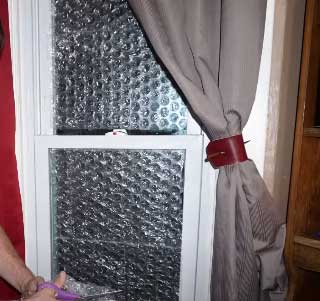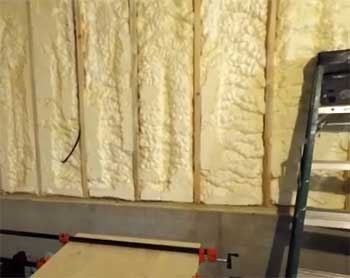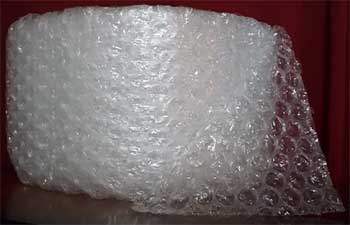Good insulation is one of the prerequisites of an energy-efficient home. Insulation is a unique system made to decrease the amount of heat that leaves a house as well as the amount of heat that comes inside a house.
Insulation is calculated through an R-value, a system that decides how tolerant these insulation techniques are to heat flow, considering the density and thickness of the material.
Between bubble wrap and foam insulation, below is a guide to help you decide which is better for your home.
A Quick Comparison Table
Don’t have time to go through the descriptive assessments? Check out this table containing brief comparisons between them.
| Specification | Bubble Wrap | Foam Insulation |
| Nature | 1 or 2 layers of foil with pressed enclosed air bubbles between them | Made of polyurethane foam or liquid latex; has to be sprayed into gaps |
| Usage | Vapor retarder, thermal break, good for many areas of a building | Restricts movements of moisture and air, flexible, some are non-water soluble |
| Best For | Pole barns, pipe wraps, roofs, crawl spaces, walls, attics, water tanks, air-conditioning devices | Floors, ceilings, walls, attics, crawl spaces |
| Installation | DIY-friendly can be done while the house is under construction or after it has been finished through retrofitting | Requires special certification and equipment; can be applied in small spray containers or larger quantities |
| Price | Cheaper | Pricier |
Key Differences Between Bubble Wrap and Foam Insulation
- Nature
Bubble wrap insulation features 1 or 2 layers of foil containing pressed enclosed air bubbles between them. This radiant barrier can decrease radiant heat, maintaining a comfortable temperature in your home, warehouse, pole barn, or office.

It is available in two variants: single bubble and double bubble. As you can guess from the names, the difference lies in the layers of bubbles.
Single bubble insulation comes with a layer of bubbles encapsulated between the outer layers whereas double bubble insulation has 2 sheets of bubbles.
External layers are available in two different kinds too.
The first is often termed bubble white and carries polyethylene bubbles (single and double options to choose from) between a layer of white polyethylene and another layer of the metalized low-emitting exterior.
The second type is known as bubble reflective insulation and includes 2 layers of low-emissivity, metalized surfaces.
Made of polyurethane foam or liquid latex, spray foam insulation is designed to cover crevices and gaps within walls or other surfaces.
Spray foam insulation is simply sprayed inside a gap where it expands and hardens, filling the gap.
Similar to bubble wrap, spray foam is of two types: open-cell foam and closed-cell foam. Between the two, open-cell foam is less dense – an R value of around R-3.7 per inch of thickness.
In comparison, closed-cell foam is much denser, with its R-value close to R-6.2. Naturally, the latter is more expensive.
- Usage

Bubble white’s nice white finish allows you to use this in many areas of a building.
In addition to acting as a vapor retarder, bubble wrap insulation can provide a thermal break.
Bubble reflective insulation, on the other hand, is recommended for long-term jobs as it is generally more expensive.
However, experts claim that it pays off in the long run.
Logically, the insulation is strengthened where two layers are done and it also offers a greater thermal break. Thus, it’s commonplace to use both external and internal insulation for places where you need extra protection.
If the required insulation is a project of closing a small leak or gap, you could probably do it by using open-cell spray foam. For this, you will have to pay between $1.00 to $1.20 per square foot.
You may want to call in a professional or use closed-cell spray foam for bigger projects.
Because of how flexible it is, spray foam insulation is perfect for oddly-shaped and hard-to-reach areas, plus small cracks, crevices, and gaps. It sets significantly fast and can be stained, trimmed, or painted.
It’s noteworthy that closed-cell spray foam resists the movement of moisture and air while open-cell spray foam only prevents the passing of air. Open-cell foam is cheaper and lighter but should never be used underground level – any place where it can absorb water.
Some less common variants of foam insulation include Tripolymer foam and Icynene foam. Tripolymer foam is a water-soluble foam that is pushed into wall cavities. Builders love it for its excellent tolerance to air and fire intrusion.
Icynene foam can be injected or sprayed, which makes it more versatile. Moreover, it has decent resistance to water and air intrusion alike.
- Best For
In general, spray foam insulation is best for floors, ceilings, and walls. Open-cell spray foam can expand to a maximum of 100 times its actual size, covering every nook and cranny of narrow spaces, such as an attic.
As its primary ingredients are organic compounds acquired from petroleum essence and water-blown, open-cell spray foam is environmentally safe.
For attics, spray foam gets a Class-Class One Fire Rating, which says that it does not retain water so it will not promote the growth of mold and mildew.
Furthermore, it forms an air seal that effectively reduces monthly energy consumption, and insulates the roof deck of unvented attics to create a semi-conditioned space.

Foam insulation is best to provide an air seal and heat resistance to decrease air leakage in walls.
For the walls of a crawl space, spray foam insulation would be the best choice as it is a non-water-sensitive type of insulation.
There is one disadvantage of spray foam: it’s more expensive than conventional insulation forms and too complicated for DIY projects.
Bubble wrap insulation is mostly used in commercial and residential buildings including metal establishments. However, it’s optimal for use in a variety of situations, such as:
- Pole barns
- Pipe wraps
- Home structures and spaces such as roofs, crawl spaces, walls, and attics
- Water tanks
- Air-conditioning devices
- Dog houses
Although bubble wrap has some disadvantages in comparison to other types of insulation, the biggest pro is that it decreases heat transfer through reflective foils, and it helps regulate the temperature inside.
It can keep the external heat inside during the summer and outside during the winter, lower cooling costs, is easy to work with and lightweight, flexible, soundproof, traps condensation, is eco-friendly, enhances building HERS rating, requires no additional equipment to install, and is cost-effective.
- Installation
There are two options for the installation of bubble wrap. First, you can install it when constructing the structure (the recommended method). It’s cheaper and easier to do then as you do not have to take out old insulation layers.
The other option is called retrofitting and in contrast to the first method, has to be done after the building has been completed. New layers of insulation can be applied to walls, roofs, and floors once the old insulation is broken down.
New insulation can be applied over old insulation too, but only if the former layers have dried out or are not damaged or ripped.
If you are applying a new bubble layer insulation on top of an old one, keep in mind that an air gap needs to be left in the middle. This ensures the moisture does not get stuck there.
The best seasons to apply bubble insulation are fall and spring as they help decrease exposure to severe temperatures. Spread out the insulation across the purlins for metal joists keeping the shiny side up – regardless of whether you are installing during or after construction.
Let the insulation “droop” amidst the points of attachment, making sure there is at least 1” air space between it and the insulated surface.
If you are applying on a flat surface, do it along the roofline. Make sure there is no dust or debris on the metalized surface to optimize the final results.
Keep in mind that bubble wrap does not usually attach well around punctures. You might have to mix it with other insulation agents like spray foam.
Speaking of spray foam, mixed with a foaming agent, liquid foam insulation can be applied with a small spray container or in bigger quantities. Both kinds harden and expand as the mix cures. Additionally, they sit inside the cavity’s shape, sealing and filling it properly.
Slow-curing liquids are available too. These foams are made to flow over hindrances before curing, and they can be used for empty wall crevices in existing structures.
Special certification and equipment are required for the installation of most kinds of liquid foam and can be done by experienced individuals.
If you are doing it, remember that an approved thermal barrier has to cover all foam materials; and the thermal barrier’s fire resistance should match that of a ½” gypsum board.
A few building codes do not count sprayed foam insulation as vapor barriers, so you may need an extra vapor retarder.
Now, watch the video explaining window insulation with bubble wrap!
- Price
Foam insulation and installation generally cost more than bubble wrap. However, as foam insulation’s R-value is greater and it can form an air barrier, it eventually reduces a few other costs associated with weather-proofing a house, like applying vapor barrier and housewrap.
When building a new structure, this kind of insulation can decrease the number of contractors needed and construction time, saving money.
Which One Will Be the Best Fit for You?
Technically, there is no one-size-fits-all answer to the question. Both bubble wrap and foam insulation come with pros and cons, and each works better for particular purposes.
What will work best for you depends on your home, where you live, your budget, what part of the house you want to insulate, and whether the house has already been constructed or not.
Bubble wrap is more effective in mixed or warm climates so have that in mind when deciding.
Frequently Asked Questions (FAQs)
Bubble wrap, while capable of providing some insulation, is not as good at it as foam. Foam layers expand and fill crevices seamlessly.
Thus, foam is better for insulation.
Despite what they may look like, bubble wraps provide good insulation due to their design. The small air pockets paired with the plastic base material heat products up quickly.
Bubble wrap’s closely-placed air pockets help this material regulate the temperature of the surface- cold or hot.
The R-value of double bubble insulation is R-1.1.
Final Words
Faced with the dilemma of bubble wrap vs. foam insulation, you will have to select one that will work the best for your home. Both insulation methods have their strengths and weaknesses. Ultimately, your budget and needs will determine the better option for you.
We strongly recommend you consider the few factors we mentioned today before making the investment.

Hi Ralph
I am considering putting insulation on my garage door and I live in south Florid, the door faces the south and garage temperature reaches well above 95°. My delimena is double/bubble or foam core, reflective insulation. The other delimena is it’s a 170mph hurricane door with multiple cross braces, and extra panel hinges. I used a scrap piece from my neighbor of DB reflective inside, white on the inside and gained a 8-9° drop in temperature on the door. Just asking for any suggestions?